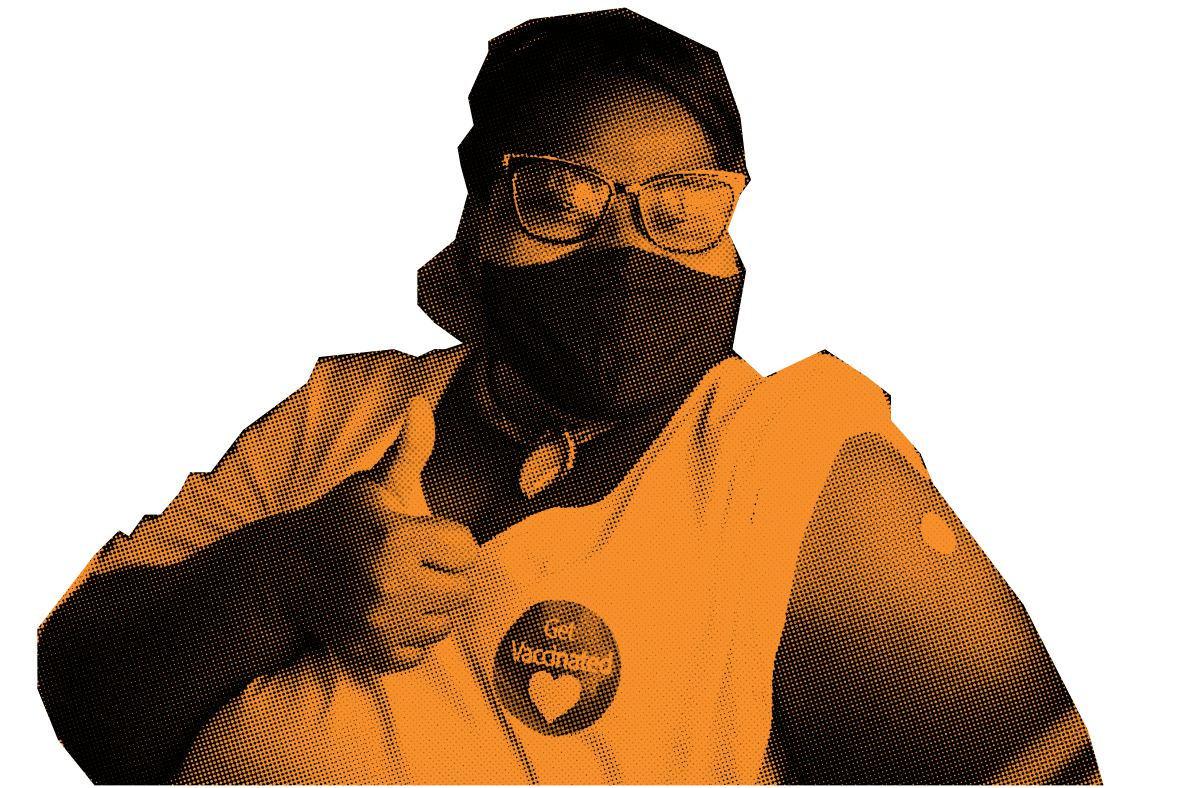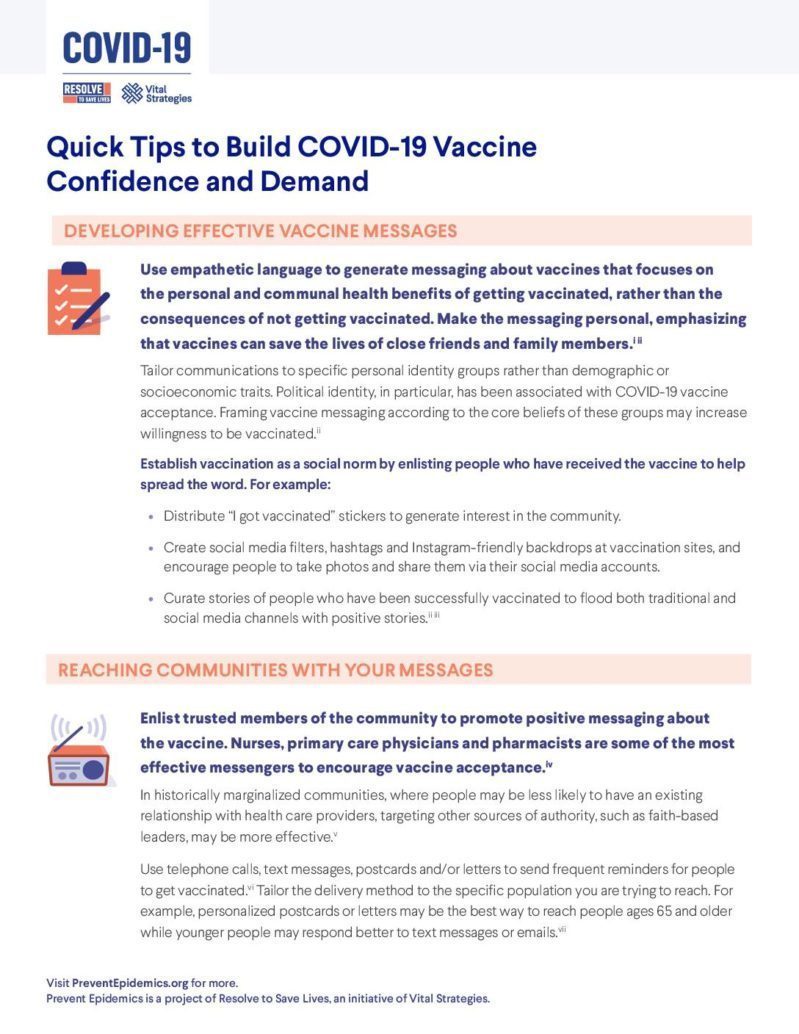Download All Country Data
Developing Effective Vaccine Messages
Tailor communications to specific personal identity groups rather than demographic or socioeconomic traits. Political identity, in particular, has been associated with COVID-19 vaccine acceptance. Framing vaccine messaging according to the core beliefs of these groups may increase willingness to be vaccinated.ii
Establish vaccination as a social norm by enlisting people who have received the vaccine to help spread the word. For example:
- Distribute “I got vaccinated” stickers to generate interest in the community.
- Create social media filters, hashtags and Instagram-friendly backdrops at vaccination sites, and encourage people to take photos and share them via their social media accounts.
- Curate stories of people who have been successfully vaccinated to flood both traditional and social media channels with positive stories.ii iii
Reaching Communities With Your Messages
In historically marginalized communities, where people may be less likely to have an existing relationship with health care providers, targeting other sources of authority, such as faith-based leaders, may be more effective.v
Use telephone calls, text messages, postcards and/or letters to send frequent reminders for people to get vaccinated.vi Tailor the delivery method to the specific population you are trying to reach. For example, personalized postcards or letters may be the best way to reach people ages 65 and older while younger people may respond better to text messages or emails.vii
Provide educational resources and information about the vaccine in the form of brochures, pamphlets, or posters that are written in simple, easy-to-understand language with informative graphics and pictures. These can be distributed at primary care physicians’ offices, local health clinics and health departments, places of worship, community centers, and other places people may visit, including local stores. These interventions are especially effective with parents and caregivers.viii
Try disseminating this information through as many mediums as possible, including radio, podcasts, television, text messages, phone calls and email to reach a wider audience and account for populations who may have limited or no internet access.ix
Misinformation often flourishes on social media platforms. Urge federal representatives to elicit government support to counter misinformation on these sites by working with social media companies or efforts, such as the United Nation’s Verified initiative to apply flags and warning labels on social media posts promoting false or misleading information.vii
Making It Easier To Get Vaccinated
Then develop creative solutions that remove common barriers to access. For example, extending pharmacy hours or providing financial compensation for the secondary costs of vaccination, such as transportation and childcare, can encourage vaccine uptake.ii
Increase the convenience of being vaccinated by setting up vaccination clinics in unconventional venues that are familiar and accessible to the community, such as local schools, religious institutions, workplaces, community centers and even pop-ups outside of local grocery stores.x
Download PDF Version
References
- deBeaumont. (2021). Poll: The Language of Vaccine Acceptance [Data set]. Retrieved from https://www.debeaumont.org/covid-vaccine-poll/
- Motta, M., Sylvester, S., Callaghan, T., & Trujillo, K. L. (2020, September 8). Encouraging COVID-19 Vaccine Uptake through Effective Health Communication. https://doi.org/10.31235/osf.io/4d25e
- Wood, S., & Schulman, K. (2021). Beyond Politics — Promoting Covid-19 Vaccination in the United States. New England Journal of Medicine. doi:10.1056/nejmms2033790
- Isenor, J. E., Edwards, N. T., Alia, T. A., Slayter, K. L., MacDougall, D. M., McNeil, S. A., & Bowles, S. K. (2016). Impact of pharmacists as immunizers on vaccination rates: A systematic review and meta-analysis. Vaccine, 34(47), 5708–5723. https://doi.org/10.1016/j.vaccine.2016.08.085
- Wallis, C. (2021, January 7). The best evidence to overcome COVID vaccination fears. Scientific American. https://www.scientificamerican.com/article/ the-best-evidence-for-how-to-overcome-covid-vaccine-fears1/
- Jacobson Vann, J. C., Jacobson, R. M., Coyne-Beasley, T., Asafu-Adjei, J. K., & Szilagyi, P. G. (2018). Patient reminder and recall interventions to improve immunization rates. The Cochrane database of systematic reviews, 1(1), CD003941. https://doi.org/10.1002/14651858.CD003941.pub3
- Thomas R. E., Lorenzetti D. L. (2018). Interventions to increase influenza vaccination rates of those 60 years and older in the community. Cochrane Database of Systematic Reviews, 5, CD005188. https://doi. org/10.1002/14651858.CD005188.pub4
- Sadaf, A., Richards, J. L., Glanz, J., Salmon, D. A., Omer, S. B. (2013). A systematic review of interventions for reducing parental vaccine refusal and vaccine hesitancy. Vaccine, 31(40), 4293-4304. https://doi. org/10.1016/j.vaccine.2013.07.013.
- United Nations Children’s Fund. Vaccine Misinformation Management Field Guide. New York, 2020.
- Schoch-Spana, M. et al. (2020). The public’s role in COVID-19 vaccination: Human-centered recommendations to enhance pandemic vaccine awareness, access, and acceptance in the United States, Vaccine. https://doi.org/10.1016/j.vaccine.2020.10.059.





